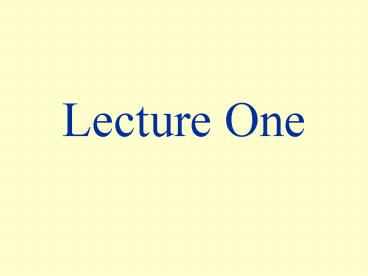Lecture One - PowerPoint PPT Presentation
1 / 49
Title: Lecture One
1
Lecture One
2
Introduction
3
Unfortunate Relativity
4
Everything is relative.
5
Criticism of Everything is relative
- Russell Chapter 2
- Feynman Vol.I, Chapter 16, Section 1
- Bohm Chapter I
6
????
- B. Russell, The ABC of Relativity, Chap. 2
7
??????
- Feynman Lecture, Vol. I, Chap. 16, Section 1
8
D. Bohm, The Special Theory of Relativity, Chap. 1
9
Unfortunate Relativity
- Perhaps the name is unfortunate.
- B. Russell
- The ABC of Relativity, Chap. 2
10
Unfortunate Relativity
- The name relativity theory was an
unfortunate choice The relativity of space and
time is not the essential thing. - A. Sommerfeld
- quoted by Taylor and Wheeler
- in Spacetime Physics, 2nd ed., p. 53
11
Unfortunate Relativity
- The principle of relativity was first stated by
Newton. - R. Feynman
- Feynman Lectures, vol.I, p.15-1.
12
Relativity Principle(earliest statement)
- The motions of bodies included in a given space
are the same among themselves, whether that space
is at rest, or moves uniformly forward in a
straight line without any circular motion. - Sir Issac Newton
- Principia, Corollary V.
13
Relativity Principle(earliest statement)
- Sir Isaac Newton, Principia
quoted by Jeans, Feynman, Resnick, and maybe
others.
14
Relativity Principle(modern statement)
- Einstein, 1905
15
The characteristic postulateofSpecial
Relativityis
- The Principle of the Constancy of the Speed of
Light - (rather than the Principle of Relativity).
16
- Thus the special theory of relativity does not
depart from classical mechanics through the
postulate of relativity, but through the
postulate of the constancy of the velocity of
light in vacuo. - A. Einstein (1916)
17
Unfortunate Relativity
- ?????(Principle of Relativity)????????
- ??????????????????
- ???????????? essential
- ???(invariance)??????
18
The constancy of the speed of light is essential
in Special Relativity.
19
E mc2
20
E mc2
- c ???????????
- m kinematics?dynamics???
21
c ? 299 792 458 m/sec(exact)
22
meter (1983)
- One meter is the distance traveled by light, in
vacuum, in the fraction 1/299,792,458 of a second.
23
second (1967)
- The second is the duration of 9,192,631,770
periods of the radiation corresponding to the
transition between two hyperfine levels of the
fundamental state of the atom of cesium 133.
24
- frequency 9192631770 cps
- wavelength 3.26 cm (microwave)
cycle per second
25
(No Transcript)
26
Phys. Rev. 137, A702 (1965)
27
- Physical Review Letter 1, 105 (1958)
28
- Cesium is the best choice of atom for such a
measurement because all of its 55 electrons but
the outermost are confined to orbits in stable
shells of electromagnetic force. - Thus, the outermost electron is not disturbed
much by the others.
29
- The cesium atoms are kept in a very good vacuum
of about 10 trillionths of an atmosphere so that
the cesium atoms are little affected by other
particles. - All this means that they radiate in a narrow
spectral line whose wavelength or frequency can
be accurately determined.
30
Classical physics failsas the speedtends to c.
31
Notation
- v relative velocity between inertial frames of
reference - u velocity of object
32
Macroscopic world
- artificial satellite (????)
- u ? 18,000 mph (miles per hour)
- u/c ? 2.710 -5
- sound wave (??)
- u ? 300 m/sec
- u/c ? 10 6
- Classical physics (Newtonian mechanics) works
33
Microscopic world
- 10 MeV electron,
- u 0.9988 c
- 40 MeV electron,
- u 0.9999 c
- ? 2 0.9988 c
- (1.9976 c)
- Classical physics fails badly as u/c ? 1
Classical Physics K ½ m u ² K ? 4 K, v ? 2 u
34
Microscopic world
- 10 MeV electron,
- B 2.0 weber/m ²
- r 1.8 cm
- ? 0.53 cm
- Classical physics fails badly as u/c ? 1
Classical Physics r m u / qB
35
????
- ?? MeV?
- 10 MeV electron????
36
MeV
- ??????
- ??(C)??(V)??(J)
- ???? e 1.610-19??
- 1 eV 1.610-19 J
- 1 MeV 1.610-13 J
37
MeV as mass unit
- 1 kg c2
- (3.0108) 2 J
- (3.0108) 2 (1.610-13) -1 MeV
- 5.61 1029 MeV
- 1 MeV/ c2 1.78 10-30 kg
38
MeV as mass unit
- ???? me 9.1110-31 kg
- me c 2 9.1110-31 5.61 1029 MeV
- 0.511 MeV ? 0.5 MeV
- ???? mp 1.6710-27 kg
- mp c 2 1.6710-27 5.61 1029 MeV
- 938 MeV ? 1000 MeV(1Gev)
39
From MeV to u ?
Not yet!
- ?? 10 MeV electron?
- ?? K ? 10 MeV ???
- ???????????
- ?? K ½ m u ² ???
- u ? (2K/m) ½
40
Connection between Mechanics and Electromagnetism
- Why the validity of classical mechanics hinges
upon the velocity of light? - Because light plays a basic role in the
measurements of space and time that underlie
mechanics.
41
By critically examining the procedures used to
measure length and time interval, Einstein
developed the Special Theory of Relativity.
42
Crucial Issues
- Principle of Relativity
- Speed of light (in vacuum)
43
Specification of an event in inertial reference
frames
- Specification of an event in a reference frame by
coordinates - Comparison of the coordinates of an event with
respect to different inertial frames of reference
44
Two ghosts in classical physics
- absolute motion
- inertial coordinate system
Einstein and Infeld The Evolution of Physics
45
The ghost of absolute motion is expelled by
Special Relativity
46
The ghost of inertial coordinate system is
expelled by General Relativity
47
Homework Assignment
- Chapter 1 2, 3, 4, 7, 8.
48
The End
49
http//www.scu.edu.tw/physics/teacher/rency/































